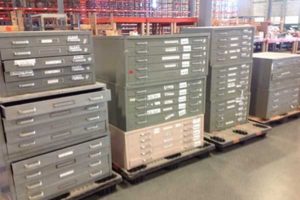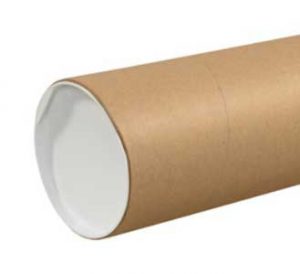The Quiet [Plate] Killer
One very common yet difficult question to answer in our industry is, “How many feet or impressions should I expect to get out of my photopolymer plates?” Considering the number of factors that must be taken into consideration, certainly anyone faced with this question should hesitate at least momentarily before answering. Aside from the processes used to make the plates and the many hands that touch the plate through a production cycle, one seemingly quiet yet critical area is plate storage.
Ideal Plate Storage
A large part of a plate’s life is spent in storage. Therefore it is important that plates are cleaned and properly stored to maximize the life span of the printing plate. A storage area should take plate cleanliness, stacking, light, ozone, and heat into consideration because all of these factors can affect plate life and performance. Putting the clean plates into protective drawers, black plastic sealed bags, or corrugated boxes will greatly reduce the possibility of the plate being damaged in storage.
As for ambient conditions, the ideal plate storage area ranges from photopolymer manufacturer to manufacturer. Some recommend a cool, dark, and dry environment, i.e. 59 - 68°F at 55% relative humidity (+/- 5%). Others find that temperatures ranging from 40 -100°F is acceptable with little or no humidity control.

Light in the plate storage area should be kept at a minimum. UV-A is long wavelength ultra-violet light. When used in platemaking UV-A forms the floor, face, and post exposure of the plate; it is also damaging to the plate post-production and can cause cracking, yellowing, diminished plate life, and hardening which effects ink release. If you are getting UV damage in your storage area, it is apparent by yellowing and hardening of the outside exposed edges of finished polymer plates. The first thing you can do is install UV-A blocking material over the over-head lighting. This will reduce hardness and allow the plates to more readily drape onto the print cylinders. Plates can be protected from light by masking surrounding windows and light sources with commercially available UV blocking tubes, sleeves, and masking sheets. The less light that reaches the finished plates, the longer the plate will last and perform properly. The use of drawers, sleeves, and corrugated boxes are all good ways to minimize exposure to light in storage.
In addition to light exposure, ozone is also harmful to finished photopolymer plates. Ozone is a gas created by the interaction of UV light and oxygen. In printing facilities high levels of ozone can be generated from corona treaters and electrical press components. Ozone damage to a photopolymer plate often shows up as small cracks on the surface of the plate. Printers can minimize a plates exposure to ozone by storing plates flat.
Photopolymer plate manufacturers typically recommend storing plates flat. Flat storage helps minimize any unwanted plate curl that may not fall in the direction that you want the plate to drape around the sleeve or print cylinder when mounted. When stacking plates never stack them face to face, but rather all facing in the same direction (face to back). Stacking plates face to face increases the chance of them sticking together when removed from storage and also increases the possibility of the impression from one plate to transfer to another. Use the foam sheets from the raw material plate packaging as separation sheets between the finished polymer plates in any storage system. If a separator sheet is not used, the plates are likely to stick to one another over time, even if the plate has been detacked/light finished in the platemaking process. Once plates begin to stick to one another, it is likely that damage will be incurred while separating the plates. Minimizing the stacking height to 6” or less will aid in preserving the integrity of the plate during storage.
The Reality of Plate Storage

I know what many of you are thinking, “We don’t have the room or storage drawers to store our plates flat!” Well my friends you are not alone, and many of us have more vertical space than floor space.
If plates are stored hanging, as is the case in some corrugated operations, make sure plates are not hung under skylights, windows, or close to warehouse lighting. Plates left mounted on print sleeves or cylinders should be wrapped with black opaque polyethylene when possible.
Many printers utilize roll cores or tubes for horizontal rolled plate storage. Horizontal tubes can also be stacked/layered in rows to take advantage of vertical storage space. Again, use the foam sheets from the raw material plate packaging as separation sheets between the finished polymer plates. When rolling groups of plates for storage it is common to roll the plates with the plate facing inward. The benefit to this method is to minimize damage when sliding the plates in and out of the storage tubes. The downside to rolling the face of the plate facing inward is that it also subjects the plates to curl away from the print cylinder. This along with possible plate hardening from UV compounds make it more challenging for the plate to naturally drape onto the print cylinder. Wrap the copy or face side of the plates facing outward in the machine direction, then wrap the outer exposed plate face with a foam sheet as well. This will minimized damage, and help block UV if tucked around the outward facing plate edges while in storage. A cap on the storage tube/core will also minimize UV and Ozone damage.
If you want to learn more about this subject, please feel free to reach out to us by calling 1-800-445-4017, or by e-mail at [email protected].
All Printing Resources has formed our Technical Solutions Group (TSG) to encompass our full range of expertise in all critical areas of the flexo process. This team is made up of industry professionals dedicated to being up-to-date on new technologies along with best practices. They are armed with the latest in diagnostic tools and are experienced in problem-solving that can achieve sustainable results. The TSG has walked in your shoes, and have felt your pain.
